Parenting a child with Autism Spectrum Disorder is a rewarding but equally inspiring experience. As autism affects people uniquely, this leads to different views or perceptions of the world that surrounds it, as well as a tendency to interact with it. Consequently, safety awareness is essential in parenting. Some of the related safety concerns in such cases would be wandering and sensitivity to sensory stimuli. This article will summarize practical safety measures and tips that parents can follow to ensure their children with autism are out of harm’s way.

Understanding Autism and Safety Awareness
Autism Spectrum Disorder, often shortened to ASD, is a neurodevelopmental disorder characterized by differences in communication, behavior, and social interactions. Most of the time, these differences affect the way in which a child perceives risks and react to their surroundings. Children with autism might have different information processing, hence better understanding or responding to varying cues in their environments and to changes in their surroundings. Parents should, therefore, be aware of autism and safety awareness for them to facilitate the needs of a child with autism.
The challenges and issues children with autism face deserve customized safety features to handle them: Overwhelming sensation and danger perception. For instance, loud noise or bright lights might overwhelm the child. The home environment should, therefore, be calm and warm. Further, dangers such as traffic or even strangers are not recognized by the child, meaning that there must be rules of safety that are consistent and clear.

General Safety Tips for Kids with Autism
Creating a safe environment for children with autism begins at home, where they feel most secure. It’s important to consider their unique needs and sensitivities when arranging their living space. Here are some essential tips to ensure their safety and comfort.
Create Sensory-Friendly Spaces
Decide which rooms in your home would be advantageous, such as a quiet corner with soft lighting and calming textures. Make sure to include things like noise-canceling headphones or weighted blankets to give the students that feeling of comfort and relieve them of overstimulation.
Prioritize Supervision
Monitor your child at all times inside and outside the house so that risk is prevented. You can fit Safety Gates on some doors and install alarms for doors and windows. Also, come up with a routine to check on them sometimes.
Maintain Comfort in Public
When visiting new environments, help the child feel safe and comfortable. Bring familiar comfort items like a favorite toy or blanket and plan for potential sensory issues by identifying quiet spaces or planning breaks to work through overstimulation.
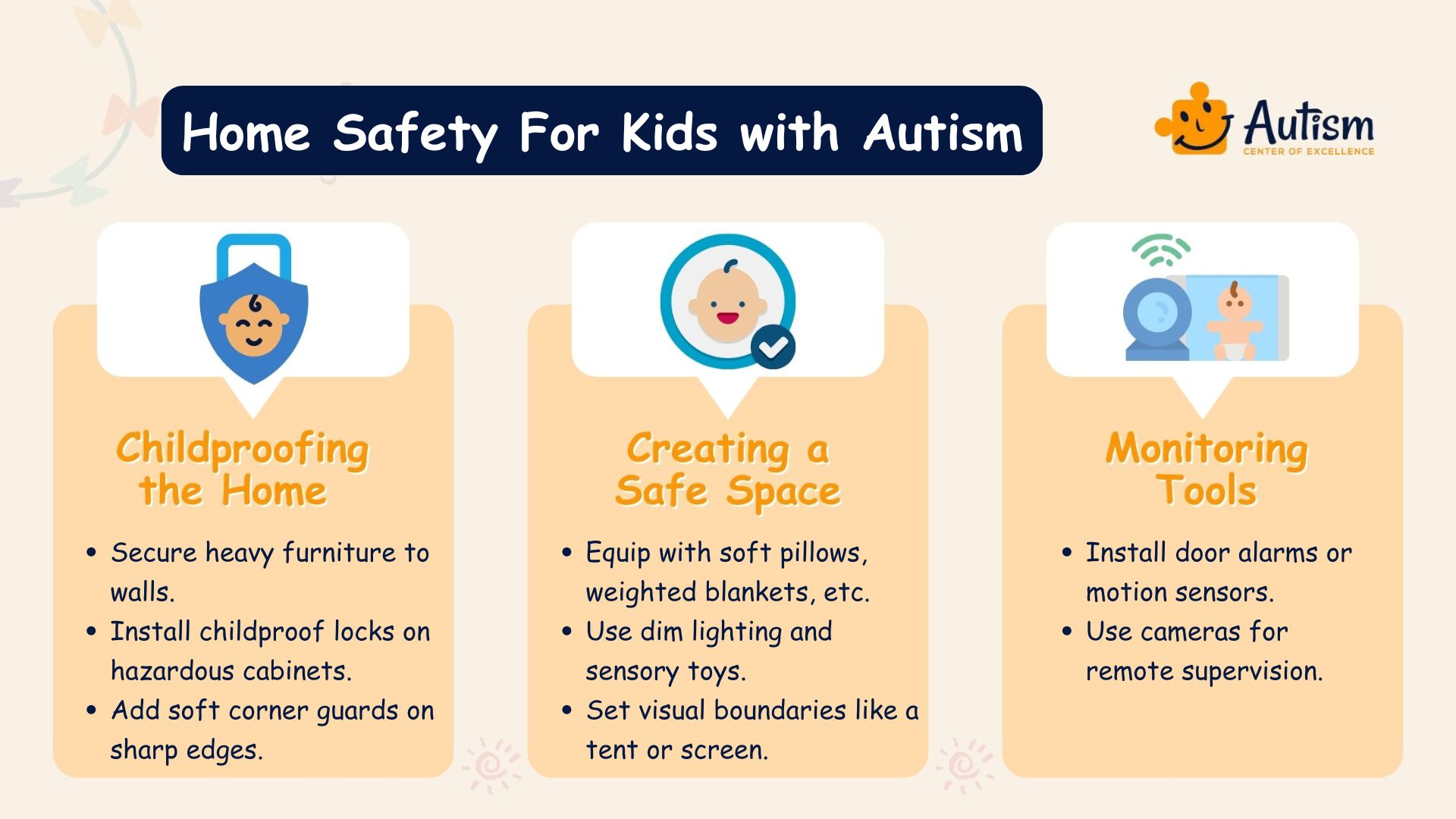
Home Safety
Childproofing the Home
Securing the home is the first step in reducing risks. Much like babyproofing, childproofing for children with autism involves.
- Securing heavy furniture to the walls to prevent tipping.
- Installing childproof locks on cabinets containing hazardous materials.
- Using outlet covers and cord organizers to prevent electrical accidents.
- Placing soft corner guards on sharp furniture edges to reduce injury risks.
Since children with autism may explore their surroundings without understanding potential dangers, childproofing provides a safer environment for them to learn and play freely.
Creating a Safe Space
Children with autism often experience sensory overload, making it important to designate a calm, Sensory-Friendly area at home. This space can be equipped with:
- Soft pillows, weighted blankets, or beanbags to help with sensory regulation.
- Dim lighting or sensory toys for relaxation.
- Visual boundaries, such as a tent or screen, to create a sense of security.
Having a safe retreat allows the child to calm down when overstimulated or anxious.
Monitoring Tools
Using monitoring tools ensures supervision, especially in high-risk areas like kitchens and bathrooms. Parents can install,
- Door alarms or motion sensors to alert them if the child enters unsafe areas.
- Cameras to remotely monitor the child’s activity, providing peace of mind.
Monitoring tools reduce the risk of accidents and allow parents to respond promptly when needed.
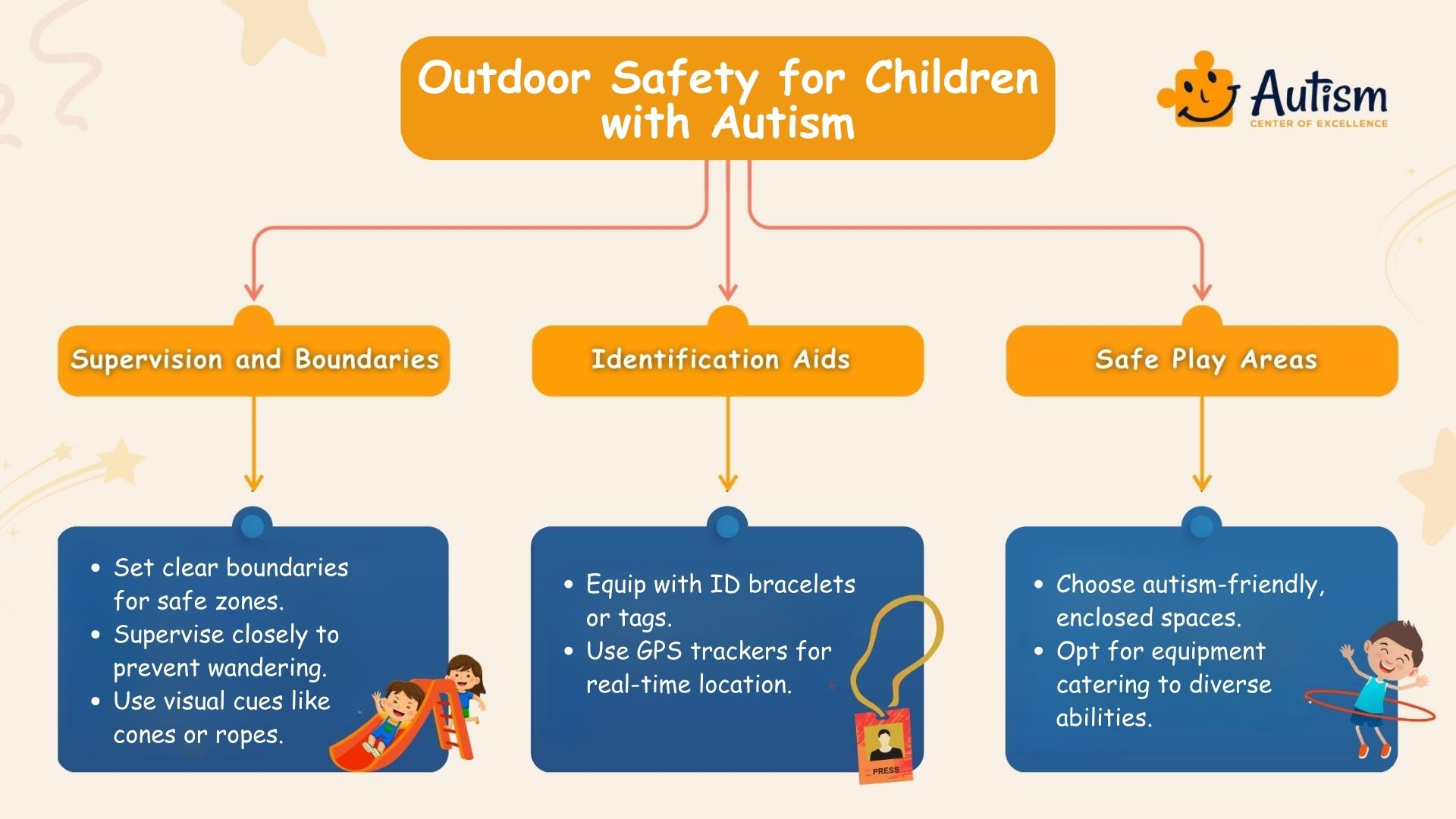
Outdoor Safety
Supervision and Boundaries
Outdoor spaces provide great opportunities for play and exploration, but supervision is essential. Children with autism may struggle with danger awareness and could wander off. Parents can ensure safety by
- Setting clear boundaries about where the child can and cannot go.
- Supervising outdoor activities closely.
- Using visual cues, such as colored cones or ropes, to mark safe play zones.
Identification Aids
To prevent dangerous situations during outings, parents can equip their child with identification aids:
- ID bracelets or tags with the child’s name, emergency contact, and medical information.
- GPS trackers that allow parents to monitor the child’s location in real time.
These tools help parents quickly locate and identify their child.
Safe Play Areas
Not all playgrounds are designed with the needs of children with autism in mind. Look for autism-friendly play areas that provide:
- Safe, enclosed spaces to prevent wandering.
- Equipment designed for children with varying abilities and sensory needs.
Choosing the right play areas ensures the child enjoys outdoor activities safely and comfortably.
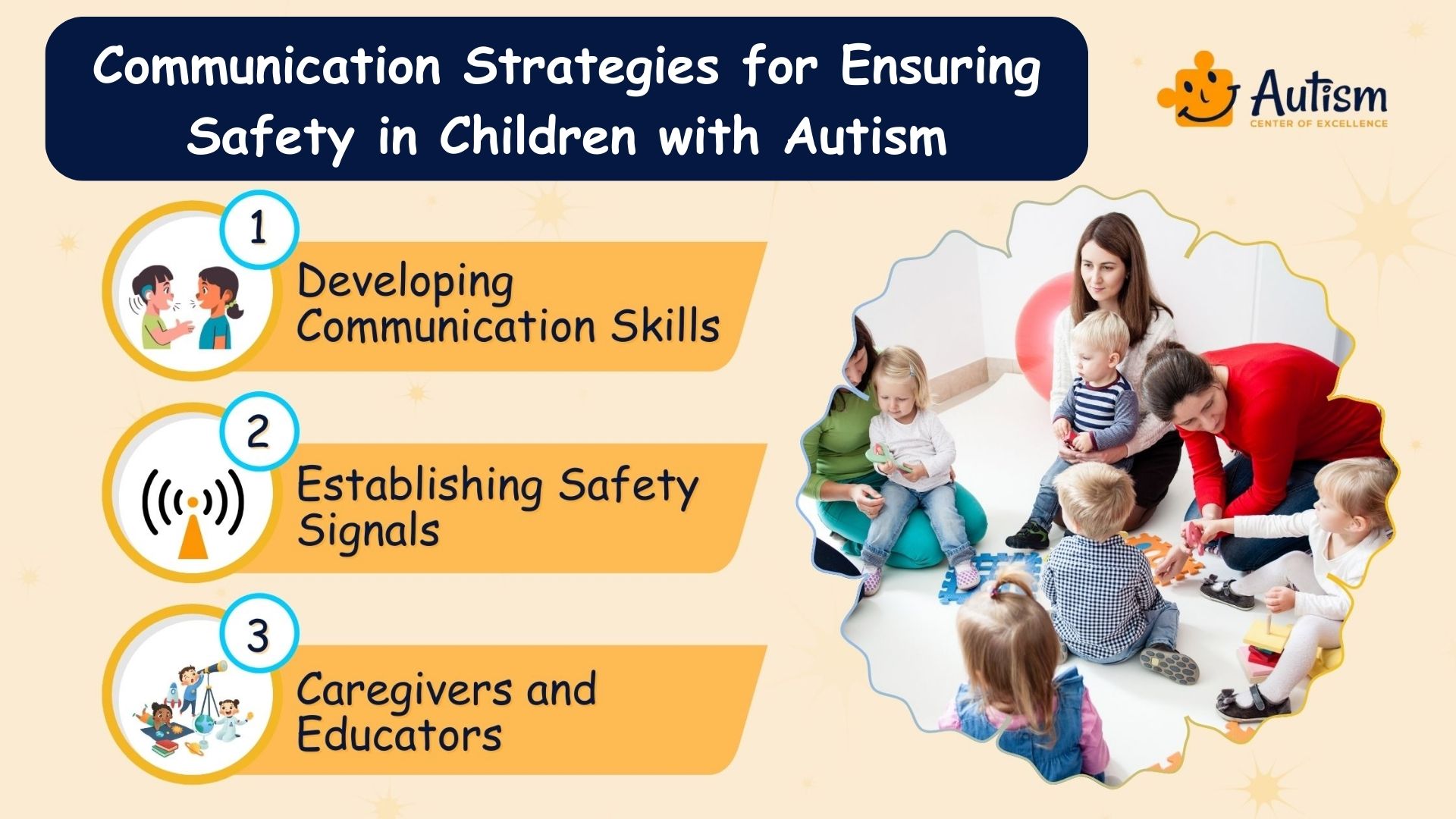
Communication Tips for Keeping Kids with Autism Safe
Developing Communication Skills
Children with autism often rely on alternative communication methods, such as visual aids or communication devices. Parents can:
- Use PECS (Picture Exchange Communication System) to enhance understanding.
- Encourage the use of simple apps or speech-generating devices to Build Communication Skills.
These tools reduce frustration and help children express their needs effectively.
Establishing Safety Signals
Teaching simple safety signals or keywords helps children express discomfort or alert others in dangerous situations. Signals can be verbal or non-verbal, such as using a “stop” gesture or saying a specific word to indicate distress.
Collaborating with Caregivers and Educators
All caregivers and educators involved in the Child’s Life must be consistent with safety practices. Regular communication between parents, teachers, and therapists ensures everyone follows the same methods for Behavior Management and safety, fostering a stable environment for the child.
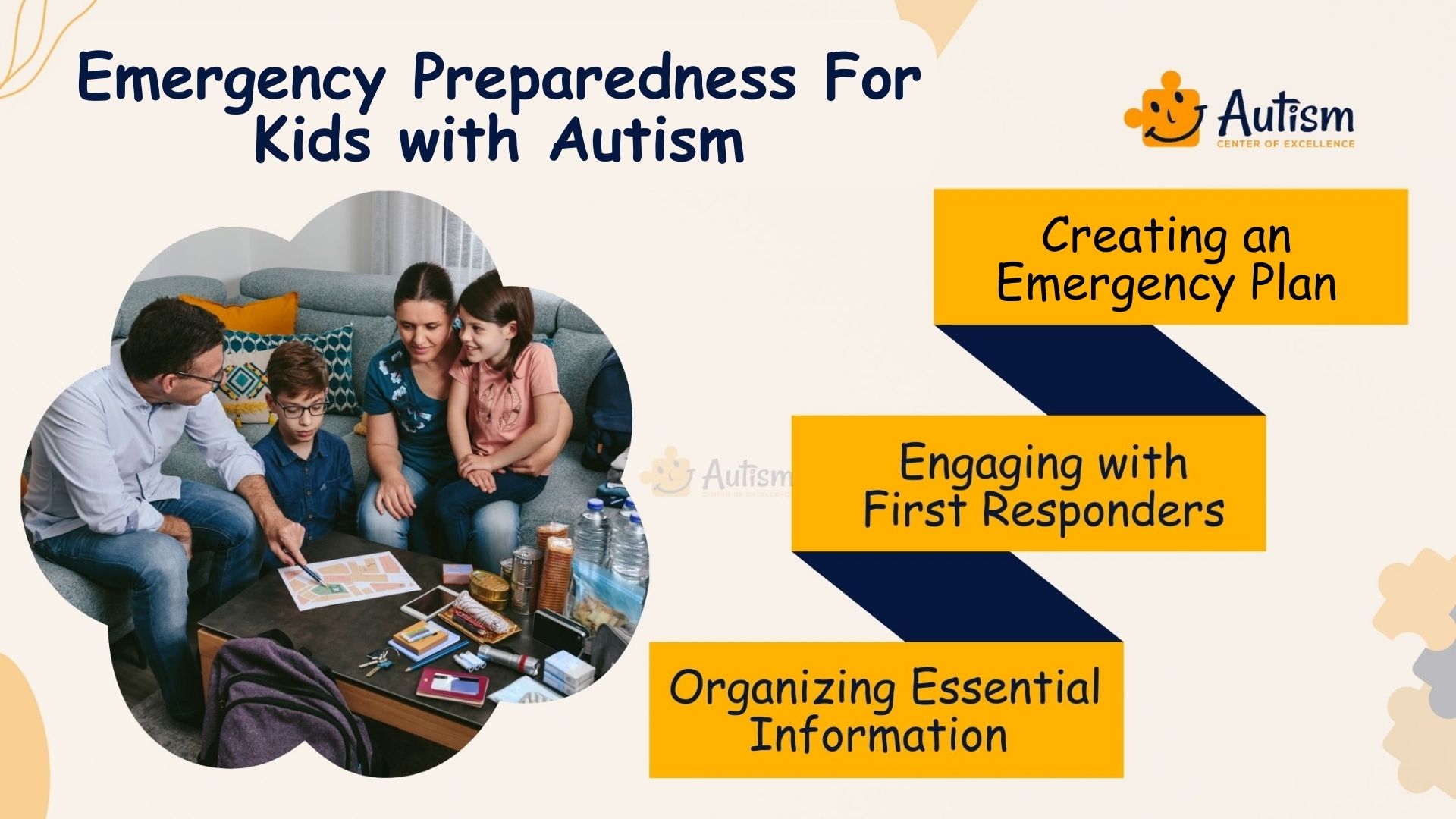
Emergency Preparedness
Creating an Emergency Plan
Having a clear emergency plan helps families respond calmly during crises such as fires, medical emergencies, or natural disasters. Parents should:
- Develop visual schedules or social stories explaining emergency protocols.
- Practice drills regularly to ensure the child knows what to do.
Preparedness reduces anxiety for both parents and children in high-stress situations.
Engaging with First Responders
Parents can notify local emergency responders about their child’s specific needs. Some communities offer autism awareness training to emergency personnel, helping them understand how to interact calmly and effectively with children on the spectrum.
Organizing Essential Information
It’s important to keep medical records and emergency contact information easily accessible. Parents can use:
- A medical alert card outlining the Child’s Diagnosis and needs.
- A portable binder or app to store essential information.
This ensures first responders have the information they need to provide appropriate care.
Enjoying Reading?
Join Our Weekly Newsletters!
Subscribe now to stay updated with our latest email updates.

Autism and Water Sensitivity
An individual’s spectrum of autism has increased water sensitivity, which may impact their processing strongly. Experience may be the primary reason why one feels highly uncomfortable with activities such as bathing, swimming, or even hand washing. As such, basic everyday personal activities that involve water exposure become problematic for them, and they require additional support and strategies to help them handle sensory overload but feel much more comfortable.
Supervise Swimming and Water Play
Always supervise children during swimming or any other water play activities.
Install Door Alarms
Equipping door alarms that can prevent unsupervised access to pools or other bodies of water.
Teach Water Safety Skills
The article will become part of the Parenting Tips for Children with Autism so that they are empowered to enjoy water safely.
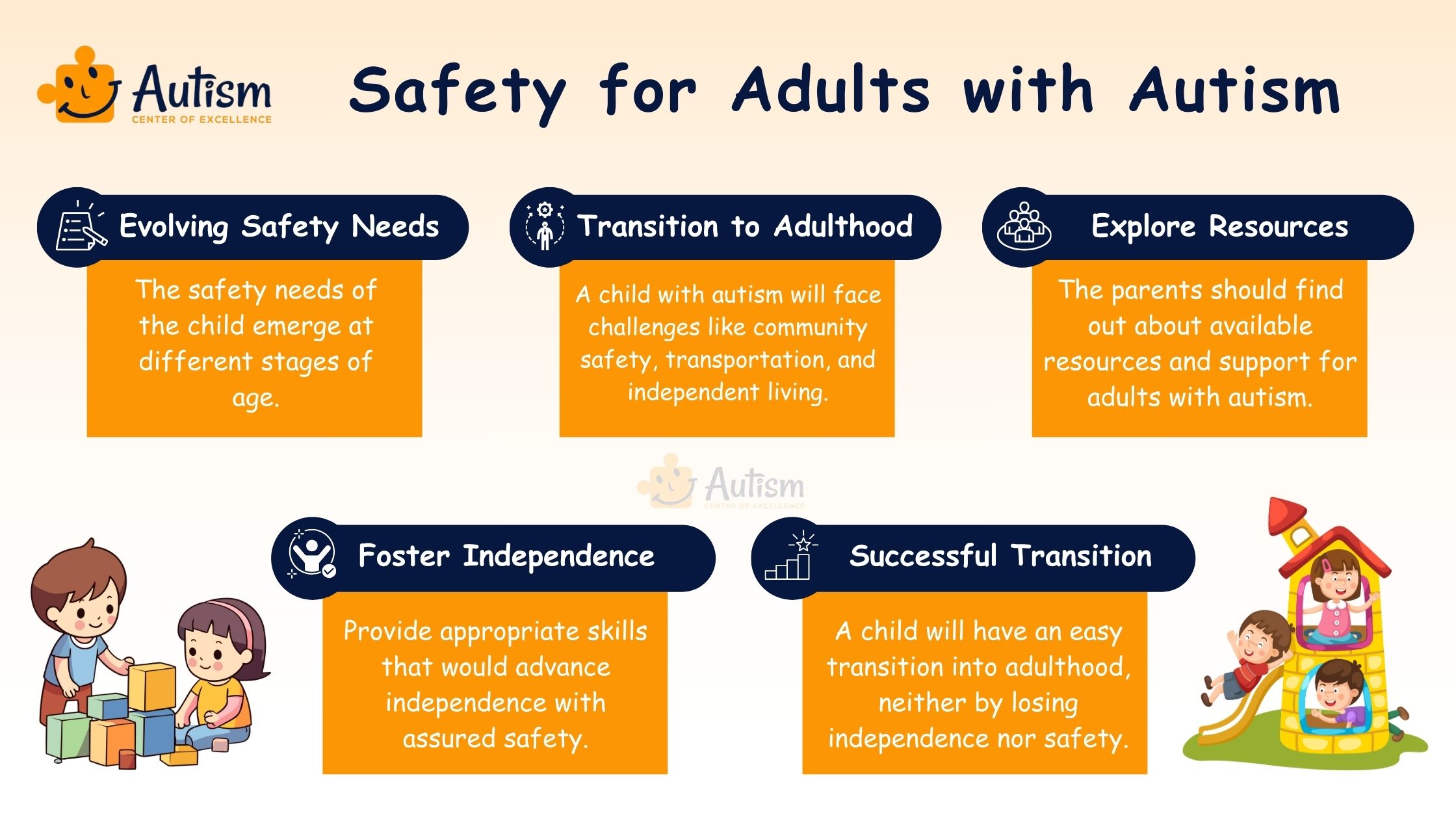
Safety for Adults with Autism
Safe Spaces for the Adult Lies in the Safety Measures Ensuring Safety Measures for adults with autism is a matter of absolute importance. This includes personalized support, raising caregivers’ and community awareness and understanding, and improving access to resources for independence and better well-being. Safety measures are the creation of safe spaces where adults can be protected from possible danger or lack of understanding.
Evolving Safety Needs
The safety needs of the child emerge at different stages of age.
Transition to Adulthood
In the transition to adulthood, a Child with Autism will face dangers like the safety of living in the community, transportation, and independent living.
Explore Resources
The parents should find out about available resources and support for adults with autism.
Foster Independence
Provide appropriate skills that would advance independence with assured safety.
Successful Transition
A child will have an easy transition into adulthood, neither by losing independence nor safety.
Frequently Asked Questions & Answer
What Are the Most Common Safety Challenges Faced by Children With Autism?
For example, children with autism can suffer from such challenges as failure to detect danger, the tendency to wander, and sensory sensitivities that may trigger panic in certain places. Strong communication barriers might also make it tough to communicate when the child feels unsafe, whereas perception of social cues and rules can be a challenge.
What Strategies Can Help My Child With Autism Understand and Remember Safety Rules?
All safety rules should be learned through visual aids like social stories or a picture schedule. Practice in various situations reminds him of those safety rules over time. Through role-playing, your child can learn various scenarios; with positive reinforcement, he will be encouraged to follow the safety guidelines.
Are There Community Resources Available to Help Parents of Children With Autism Enhance Safety?
Most communities have these resources, which may include support groups, workshops, and training for parents of children with autism. Local organizations of autism can give you more insight and connect you with services concerning occupational therapy on sensory and safety issues. Schools and health providers will be significant resources and advisors for you.
What Role Do Schools and Educators Play in Ensuring the Safety of Children With Autism?
Schools can play a huge role by finding ways through individualized education plans to help meet some of the safety needs. Schools are predictable places. They have routines involving predictable times for eating, sleeping, and daily activities. Instruction in safety skills, as well as social skills, can take place in a nurturing environment, and teachers can collaborate with parents to provide consistency within the home and school environments.
Conclusion
Safety is a continuous journey for parents of children with autism, as it requires constant vigilance and adaptation. Children with autism may have unique sensory needs and behaviors that pose specific safety challenges. By implementing the key safety tips and measures discussed—such as securing exits to prevent wandering, using visual aids and social stories to explain safety concepts, and ensuring the home environment is free from potential hazards—parents can create a nurturing environment that supports their child’s unique needs.
Staying informed and proactive is essential in this ongoing process, as safety measures should evolve as the child grows and develops new skills or encounters different environments. This might include adjusting strategies as the child becomes more independent or navigates new social settings, like school or community activities. Together, with understanding, patience, and collaboration with educators and ABA Therapy providers such as AutismCOE, parents can help their children thrive safely, ensuring they have the opportunity to explore the world and reach their full potential.
Please Note: The content of this blog is for informational purposes only and should not be considered a substitute for professional medical advice, diagnosis, or treatment. Consult a qualified healthcare professional for personalized guidance tailored to your specific situation.

Bhavika Bhasin
Bhavika Bhasin is the Research and Marketing officer at AutismCOE. She works with children and adults with ASD. Her clinical research includes evaluating various available autism screening and diagnosis methods and their efficacy. She is currently developing a novel screening exam that is indicated to be more accurate than the existing available exams. She is also writes articles papers for various publications.


